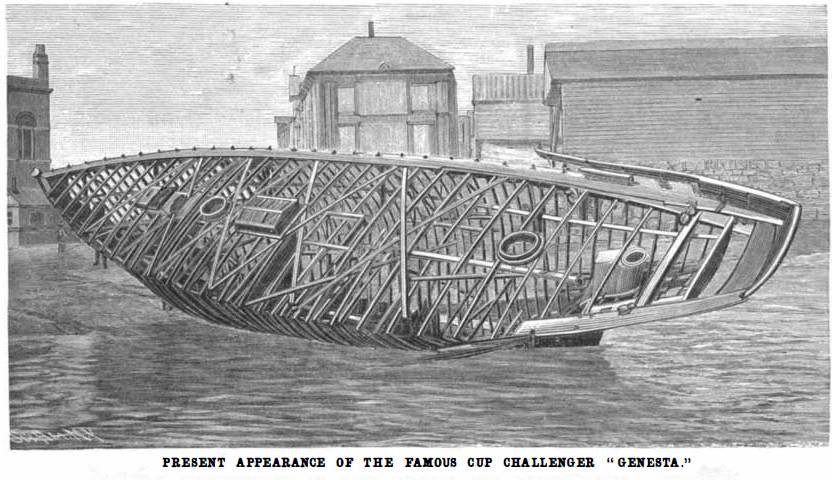
|
REF : 0
EDITION : 1885
DATE : 09 Sep 1900
COURSE : 0
DESCRIPTION SITE :
THE LAST OF A FAMOUS "AMERICA" CUP CHALLENGER.
Of all the English yachts which have come over to compete for the "America's Cup," there is probably none that has made such a good record for herself as the fine old English cutter Genesta; certainly, she came nearer winning the cup than any yacht that preceded her or came after. The American yachting enthusiast who was so fortunate as to be present at that famous race in 1885 of twenty miles to leeward and return, will not soon forget the anxiety with which he saw Sir Richard Sutton's yacht slipping down the wind to the outer mark with an ever-widening distance between her and the centerboard Puritan, nor the delight with which, when the boats hauled on the wind he saw the centerboard slowly, but steadily, out-weathering the cutter, and finally romping home the winner by the close but undeniable margin of 1 minute 38 seconds. In the light weather trial the shallow centerboard with her relatively large sail area proved to be a far faster boat than the Genesta.
Although she failed to take home the cup, Genesta was successful in winning both the Brenton Reef and Cape May cups.
The Genesta was a typical English deep-keel, outside-lead cutter of the so-called plank-on-edge type; though she was not so extreme in her relation of beam to draught as some cutters of her time, she was sent over here at a time when the “keel versus centerboard" controversy was at its height. In none of the races that have followed those of 1885 have the competing yachts of the two nations shown w strongly the distinguishing national characteristics as did Puritan and Genesta, the one being distinguished by narrow beam, deep draught, outside ballast, large displacement and relatively small sail plan; the other by great beam, shallow draught, and both inside and outside ballast, the outside ballast being the first step toward the cutter type, just as the English Thistle in adopting a beam of 20 feet showed the first tendency toward the characteristic beam of the American sloop.
The Genesta was a composite built boat (elm planking on steel frames), and measured 96 feet on deck, 81 feet on the waterline, 15 feet beam, and 13 feet 6 inches draught. She had a displacement of 141 tons and a sail area of 7, 141 square feet. The Puritan was 93 feet on deck, 81 feet 1½ inches on the waterline, 22 feet 7 inches beam, 8 feet 10 inches draught, with a displacement of only 105½ tons and a sail area of 7,370 square feet.
The accompanying illustration, for which we are indebted to The Yachtsman, shows the famous old cutter upon the beach in process of being broken up for old iron and junk, an inglorious end that overtakes all craft except a few favored warships like our own "Hartford” or Nelson's old ship, the "Victory."
LICENCE :
Autorisation en cours
| LIENS VERS CE DOCUMENT | ||||
| SITE | LARG | HAUT | ADRESSE | |
 |
Scientific American | 832 | 480 | http://www.scientificamerican.com/article/the-last-of-a-famous-america-cup-ch/ |